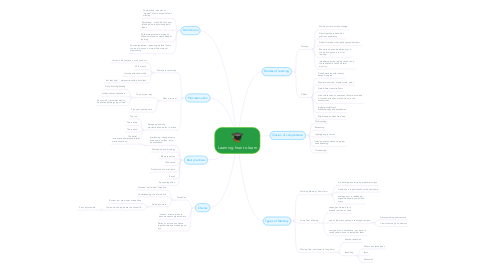
1. Best practices
1.1. Interleaving - change topics every now and then, jump around/ahead
1.1.1. increases performance in real world situations
1.2. Metaphors and Analogy
1.3. Memory palace
1.4. Take notes
1.5. Flash-cards and mini-tests
1.6. Recall
1.7. Spaced repitition
2. Procrastination
2.1. Pomodoro technique
2.1.1. focus on the process, not on product
2.1.2. 25/5 minute
2.1.3. focused attention mode
2.1.4. "eat that frog" - always start with a hard task
2.2. Planner journal
2.2.1. To-do list per day
2.2.1.1. Daily/Monthly/Weekly
2.2.1.2. utilizes subconsciousness
2.2.1.3. Daily to-do i recommended to be written before going to bed
2.2.2. Plan your quitting time
2.3. Recognize how the procrastination works in action
2.3.1. The cue
2.3.2. The routine
2.3.3. The reward
2.3.4. The belief
3. Chunks
3.1. Formation
3.1.1. Focused "undivided" attention
3.1.2. Understanding the information
3.1.3. Gaining context
3.1.3.1. Bottom-up: practice and repetition
3.1.3.2. Top-down: seeing where the chunk fits
3.1.3.2.1. 2-min picture walk
3.2. "chunks" allow actions to become seemingly automatic
3.3. Pieces of information bound together through meaning and use
4. Definitions
4.1. Compaction - transfer of “zipped” files in broad field of memory
4.2. Einstellung - a roadblock to new thinking due to previously held ideas
4.3. Deliberate practice- working on difficult material to create deeper learning
4.4. Spaced repetition - repeating material over a course of days as a more efficient way of memorizing
5. Modes of learning
5.1. Focused
5.1.1. Working from prior knowledge
5.1.2. Neural pathways based on previous experience
5.1.3. Pinball machine with tightly spaced bumpers
5.1.4. Example: spaced repetition over a course of days as a tool for learning
5.1.5. relentless practice regime tends to be concentrated in the short term memory
5.2. Diffuse
5.2.1. Pinball machine with loosely based bumpers
5.2.2. Example: exercise, shower, walk, paint
5.2.3. State where creativity flows
5.2.4. mind relaxes and connections that are not made in focused attention are firmed up in the unconscious
5.2.5. higher possibility of breakthroughs and epiphanies
5.2.6. Might happen when we sleep
6. Types of Memory
6.1. Working Memory/ Short Term
6.1.1. immediate processing by prefrontal cortex
6.1.2. Limited to 4 topics/chunks at the same time
6.1.3. analogous to a chalkboard, wiped frequently and limited space
6.2. Long Term Memory
6.2.1. things get stored over a broader portion of brain
6.2.2. one of the areas utilized is the hippocampus
6.2.2.1. Always making new neurons
6.2.2.2. Tied to learning and memory
6.2.3. analogous to a warehouse - you have to revisit certain items to remember them
6.3. Moving from short-term to long-term
6.3.1. Spaced repetition
6.3.2. Recalling
6.3.2.1. 30-seconds techniques
6.3.2.2. tests
6.3.2.3. flashcards

